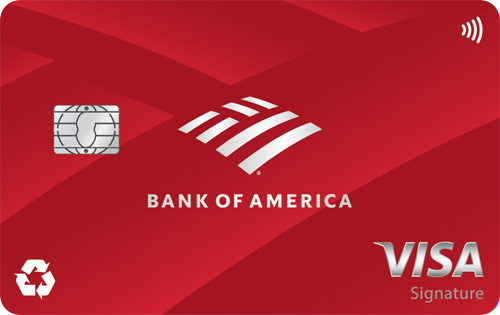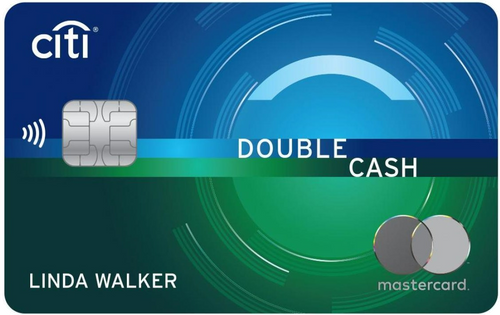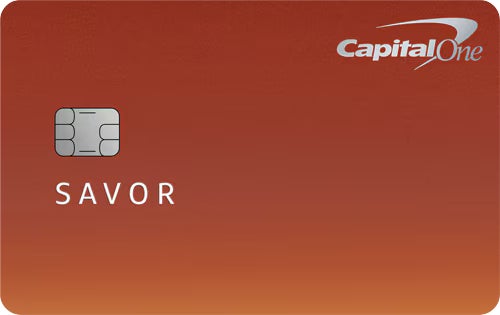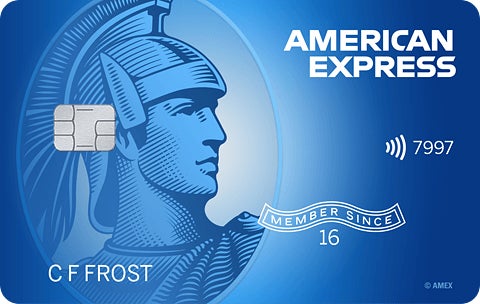| Cash Back Rating: | 4.8 / 5 |
| Rewards Value: | 4.0 |
| Annual Percentage Rate: | 1.0 |
| Rewards Flexibility: | 2.0 |
| Features: | 3.0 |
| Issuer Customer Experience | 5.0 |
In a Nutshell:
A great card for families and frequent shoppers, the Blue Cash Everyday card offers a generous amount of cash back on everyday purchases, both in-store and online.
Rewards Rate
|  |
Introductory Bonus
|  |
Annual Bonus |  |
Annual Fee |  |
APR |  |
Rewards Redemption
Cons
|  |
American Express Customer Service Ratings
|  |
Other Notable Features: Car rental insurance, travel assistance, purchase protection, family vacation packages, car purchase discounts, $7 back each month after using your Blue Cash Everyday Card to spend $9.99 or more each month on an eligible subscription to The Disney Bundle, which includes Disney+, Hulu, and ESPN+. Enrollment required. Subject to auto renewal.
| Low Interest Rating: | 2.8 / 5 |
| Rates, Fees, Penalties: | 3.3 |
| Rewards: | 3.5 |
| Features: | 4.0 |
| Issuer Customer Experience | 5.0 |
In a Nutshell:
With a reasonable interest rate, a long introductory period on new purchases and balance transfers and a great cash back rewards program, the Blue Cash Everyday card is a good choice for cardholders seeking to save.
Regular APR |  |
Introductory Purchase APR |  |
Introductory Balance Transfer APR |  |
Fees
|  |
Penalties
|  |
American Express Customer Service Ratings
|  |
Other Notable Features: Car rental insurance, travel assistance, purchase protection, family vacation packages, car purchase discounts, $7 back each month after using your Blue Cash Everyday Card to spend $9.99 or more each month on an eligible subscription to The Disney Bundle, which includes Disney+, Hulu, and ESPN+. Enrollment required. Subject to auto renewal.
Blue Cash Everyday Card from American Express: A Full Review
The Blue Cash Everyday Card offers a rewards program tailored to everyday spending, offering generous cash back in categories including U.S. supermarkets, U.S. gas stations and U.S. online retail purchases. For cardholders who spend a lot on groceries, online shopping and commuting, the Blue Cash Everyday can be one of the most lucrative cash back credit cards available.
This card is especially good if you need a high-earning cash back rate for grocery and gas expenses year-round without quarterly spending limits (although there is a yearly spending cap). Cash back on U.S. online retail purchases is a relatively unique category, which could also make the Blue Cash Everyday a solid second rewards card if you want to avoid retail credit cards.
Pros
- Offers a strong mix of rewards categories and rates, plus a decent welcome offer, all for no annual fee
- Includes an introductory APR offer on purchases and balance transfers, allowing cardmembers to save on interest
Cons
- Superstores and wholesale retailers are not included in the card’s cash back category for U.S. supermarkets
- This card’s fees include a 2.7 percent foreign transaction fee (see rates and fees), an up to $40 late payment fee and a higher penalty APR for late or missed payments (this rate lasts at least six months)
Why you might want the Blue Cash Everyday Card from American Express
On top of a great rewards rate, the Blue Cash Everyday also comes with a lengthy intro APR on both new purchases and balance transfers. If you need to finance a large purchase or chip away at debt over time without racking up interest for a generous time period — but don’t want to sacrifice rewards — this card is a great option.
Earning cash back
The Blue Cash Everyday card has a great rewards rate for a card with no annual fee. Cardholders earn 3% cash back at U.S. supermarkets, U.S. gas stations and U.S. online retail purchases (on up to $6,000 in purchases per year in each category, then 1%), and 1% cash back on general purchases.
Even with the $6,000-per-category spending cap, this could be a very lucrative rewards program. Indeed, if you maximize the category, you can earn upwards of $180 per year on U.S. supermarket purchases alone.
The card should also pair well with a flat-rate card due to its impressive category variety. If you swipe strategically, you can swap between cards to maximize your cash back, using the Blue Cash Everyday card for all bonus category purchases and a flat-rate cash back card for general purchases to boost your overall rate.
A supplemental flat-rate card will be especially useful if you frequently shop at superstores (such as Walmart or Target), specialty stores (like wine or cheese shops) or wholesale clubs (like Costco), all of which fall outside American Express’ list of eligible U.S. supermarkets.
For example, imagine you own the Blue Cash Everyday card and the Citi Double Cash® Card – which earns up to 2% cash back on every purchase (1% when you buy, another 1% when you pay off purchases). If you use the Blue Cash Everyday for all U.S. supermarket, U.S. gas station and U.S. online retail purchases and the Double Cash for everything else, you’ll earn the following reward rate:
- 3% cash back at U.S. supermarkets (up to $6,000 per year in purchases, then 1%)
- 3% cash back at U.S. gas stations (up to $6,000 per year in purchases, then 1%)
- 3% cash back on U.S. online retail purchases (up to $6,000 per year in purchases, then 1%)
- 2% cash back on general purchases from the Double Cash (1% when you buy and another 1% as you pay off your purchases).
That’s a ton of category coverage and a generous rate all available on two no-annual-fee cards.
Introductory bonus
The Blue Cash Everyday card has a welcome bonus of $200 in statement credits after spending $2,000 in the first six months. This offer is a bit lower than its previous iteration of $100 after spending $2,000 in the first six months and up to $150 back when using your card via PayPal to check out with merchants (as 20% cash back in statement credits) in the first six months. What’s great about the most recent bonus is it’s much more straightforward and attainable for most cardmembers, while remaining competitive with similar cards in its category.
Redeeming cash back
Cashing in on rewards is simple since no minimum amount is needed to redeem your rewards. You can redeem in the form of a statement credit or at Amazon.com checkout . Statement credits are your best cash back redemption option since they’re more versatile.
If you want to use your rewards for a travel purchase, you won’t be able to apply them toward American Express Travel bookings. However, you will have full access to the booking platform, and you can use your cash back toward a statement credit to offset the cost.
Intro APR for new purchases and balance transfers
The Blue Cash Everyday also comes with an intro APR on new purchases and balance transfers – 0% for the first 15 months from the date of account opening date (20.24%-29.24% Variable thereafter). This could be a great way to finance a larger purchase or pay down debt over time without worrying about racking up substantial interest charges or resorting to a risky deferred interest offer.
Just be sure you plan to pay off any outstanding balances during the intro period, as the ongoing APR can be high. While the low-end APR is a bit lower than the current average interest rate, the high-end APR is much higher than the average rate.
Other features
The Blue Cash Everyday card also comes with some additional benefits that add to its value – especially for frequent shoppers and travelers.
- Cash back on The Disney Bundle – You’ll earn $7 back each month after you use your card to spend $9.99 or more each month on an eligible subscription to The Disney Bundle, which includes Disney+, Hulu, and ESPN+ (enrollment required, subject to auto renewal).
- Home Chef meal kit subscription – up to $15 back per month when you purchase a Home Chef meal kit subscription with your Blue Cash Everyday card (enrollment required, subject to auto renewal).
- Car rental insurance – When you use the Blue Cash Everyday to book and pay for your rental car, you receive secondary coverage in case of damage or theft.
- Purchase protection – If an item you buy with your card is lost or damaged in the first 120 days, you can be reimbursed up to $1,000 per purchase in covered instances ($50,000 max per year).
- Access to pre-sales tickets – As an American Express cardholder, you’ll have exclusive access to pre-sales tickets to concerts, sporting events and more.
- “Plan It®” – Pay off small purchase amounts (under $100) right away and split larger purchases (over $100) in monthly installments with $0 intro plan fees with this flexible payment option. Payment plans will be offered 1-3 plan duration options for the qualifying purchase. Eligibility is based on your account and credit history. No enrollment required.
- Buy Now, Pay Later – When you use Plan It to split up large purchases into monthly payments, you pay $0 in plan fees as well as on plans created during the first 15 months after account opening. A plan fee of up to 1.33% APR of each purchase amount will apply to plans created after that time, moved into a plan based on plan duration. The APR would otherwise apply to the purchase, among other factors.
To take advantage of these protections, you should put all big purchases on your Blue Cash Everyday card.
See related: American Express card benefits
Customer service
American Express has one of the best customer service reputations among major issuers, finishing first among 11 issuers in J.D. Power’s 2022 customer satisfaction survey. In addition to 24/7 customer service and an online chat feature for quick answers to simple questions, the American Express app rates very well among users. It rates 4.1 out of 5 in the Google Play Store and 4.9 out of 5 in the Apple App Store.
Why you might want a different card
When looking for an everyday rewards credit card, consider your budget and where you do most of your shopping before making your decision. Depending on how much you spend at U.S. supermarkets, you may want to upgrade to the more rewarding Blue Cash Preferred® Card from American Express. And if you mostly shop at superstores and wholesale clubs, you should consider a flat-rate cash back card instead since these purchases only earn 1% cash back with the Blue Cash Everyday.
Credit score requirement for qualification
The Blue Cash Everyday card is recommended for users with good to excellent credit (above 670), so you’ll want to ensure you meet those qualifications before you apply.
Luckily, American Express offers preapproval via its website and CardMatch. Using CardMatch only requires a “soft” credit pull – which has no impact on your credit score – and it should also give you your best chance at knowing whether you’ll be approved before applying. You may even qualify for a special offer, such as an even higher welcome bonus, so it’s definitely worth a try.
Potential fees
One of the highlights of the Blue Cash Everyday is its lack of an annual fee, meaning you won’t have to worry about spending a specific amount in certain categories to recoup that value.
However, the card does have a few fees to be wary of. First, it charges a 2.7 percent foreign transaction fee. While this is a fairly standard rate, it makes the card less appealing to use abroad or with international merchants. In addition, if you pay your bill late or miss a payment, you will incur a late payment fee of up to $40 and a higher penalty APR, which can last over six months.
How does the Blue Cash Everyday compare to other cash back cards?
The Blue Cash Everyday card is a very rewarding option for users who spend a lot on U.S. supermarket and gas station purchases, but it might not be the best choice for every type of cardholder. If you prefer to earn cash back in different bonus categories or put all your spend on one card that earns a high flat rate of cash back, one of these options might be better for you:
 |  |  |
Rewards rate
| Rewards rate
| Rewards rate
|
| Sign-up bonus | Sign-up bonus | Sign-up bonus |
| Annual fee $0 | Annual fee $0 | Annual fee $0 |
Other things to know
| Other things to know
| Other things to know
|
Blue Cash Everyday® Card from American Express vs. Bank of America Customized Cash Rewards credit card
Rather than lock users into one bonus category, the Bank of America Customized Cash Rewards credit card gives cardholders the flexibility to choose where they want to earn 3% cash back – from gas, online shopping, dining, travel, drug stores or home improvements and furnishings. Plus, you can change your selection once per calendar month to shift your rewards as your spending does. The Bank of America Customized Cash Rewards credit card also offers 2% cash back on grocery store and wholesale club purchases (on $2,500 in combined purchases in 2% and 3% categories each quarter) and 1% cash back on general purchases.
If you are a Bank of America or Merrill account holder, you can even boost your cash back rate with the Preferred Rewards program. Depending on your account balance, you can earn as much as 75% more cash back on every purchase.
Blue Cash Everyday® Card from American Express vs. Citi Double Cash Card
For cardholders who prefer a flat rate of cash back on every purchase to keeping track of bonus categories, the Citi Double Cash Card offers one of the best rates on the market. You can earn 1% cash back on every purchase you make, plus an additional 1% cash back when you pay off those purchases – for up to 2% cash back on everything.
Unfortunately, one trade-off for this great rate is no intro APR for new purchases. If that feature is important to you when choosing a new card, there may be better options than the Citi Double Cash.
Blue Cash Everyday® Card from American Express vs. Capital One Savor Cash Rewards Credit Card
The Capital One Savor card offers an easy way to earn unlimited 3% cash back across a range of bonus categories, including grocery store purchases (excluding superstores like Walmart® and Target®). You’ll also earn cash back at the same rate on dining, entertainment, and popular streaming services — plus 8% cash back on Capital One Entertainment purchases.
Since the Savor earns the same 3% at eligible supermarket locations as the Blue Cash Everyday, but without the $6,000 per year spending limit, the Savor might be the better choice for foodies. However, commuters that do a lot of online shopping might be better off with the Blue Cash Everyday.
What do Blue Cash Everyday cardholders say?
Since it offers solid cash back on everyday expenses for no annual fee, the Blue Cash Everyday is a fantastic entry-level rewards card if you have good to excellent credit. In fact, the Blue Cash Everyday was what introduced Julian Riccio, director at CreditCards.com, to credit cards:
“I got it in 2016, and it was my first card. This was before I knew a lot about credit cards, so I was looking for something that was no-annual-fee, [and offered] cash back because it was easy…most of my spend at that point was groceries. It did really feel like it was a good starter card, so that’s what drew me to it.”
In his first year, Julian spent around $3,000 on groceries and earned about $90 in cash back, but he’s added another 15 credit cards to his wallet since then to maximize his rewards and has still held onto it. “I eventually got the Blue Cash Preferred because I started spending a lot more on groceries, and that trade-off started to make sense, with the $95 fee**. But then I transferred it back down to the Everyday later on when I started spending a little bit less on it,” Julian said.
**Blue Cash Preferred Card from American Express currently has a $0 intro annual fee for the first year, then $95
Another one of our CreditCards.com expert writers, Mariah Ackary, has also had firsthand experience squeezing extra value out of her everyday spending with the Blue Cash Everyday and the Amex Offers program:
“I try to be pretty frugal, so a no-annual-fee card that rewards basic expenses like groceries and gas is a staple for me. And because the mobile app is so easy to navigate, I actually use the local offers to earn even more cash back.”
Why get the Blue Cash Everyday card?
- You spend a lot with U.S. supermarkets, gas stations and online retailers and can take advantage of a good rewards rate on those categories.
- You have a large purchase or existing credit card debt you want to pay off over time and want to avoid interest in the first 15 months.
- You are looking for a card with lucrative bonus categories to pair with a flat-rate card.
- You spend less than $3,200 each year at U.S. supermarkets and wouldn’t be able to offset the Blue Cash Preferred card’s ongoing annual fee.
- You often shop online, but want to avoid a store-specific credit card
How to use the Blue Cash Everyday card:
- Put all U.S. supermarket, gas station and online retail purchases on the card.
- Use the card to finance larger purchases or pay down a balance at a 0% intro APR for the first 15 months (20.24%-29.24% Variable APR thereafter).
- Be sure to pay off any new purchases before the end of the introductory period to avoid interest charges.
Is the Blue Cash Everyday card right for you?
For cardholders who spend a significant amount on U.S. supermarket and U.S. gas station purchases, the Blue Cash Everyday card offers a generous rate of cash back for a card with no annual fee. The Blue Cash Everyday is also one of the best cards for online shopping thanks to its generous cash back at U.S. online retailers – a category that can be hard to come by and actually beats many store cards’ reward programs. Plus, you’ll get a long intro APR on new purchases and balance transfers.
However, if you have an especially large grocery budget, you might be better off opting for the Blue Cash Preferred Card from American Express – despite its $95 annual fee ($0 intro annual fee for the first year). Bulk shoppers that stock up at superstores and wholesale clubs will also want to consider another card since these prominent grocery vendors don’t count toward the Blue Cash Everyday’s U.S. supermarket category.
Eligibility and Benefit level varies by Card. Terms, Conditions and Limitations Apply. Please visit americanexpress.com/benefitsguide for more details. Underwritten by Amex Assurance Company.
For rates and fees of the Blue Cash Everyday Card, please click here.
*All information about the American Express Cash Magnet Card and the Bank of America® Customized Cash Rewards credit card has been collected independently by CreditCards.com and has not been reviewed by the issuer.
Our reviews and best card recommendations are based on an objective rating process and are not driven by advertising dollars. However, we do receive compensation when you click on links to products from our partners. Learn more about our advertising policy
Frequently Asked Questions
All reviews are prepared by CreditCards.com staff. Opinions expressed therein are solely those of the reviewer and have not been reviewed or approved by any advertiser. The information, including card rates and fees, presented in the review is accurate as of the date of the review. Check the data at the top of this page and the bank’s website for the most current information.
Responses to comments in the discussion section below are not provided, reviewed, approved, endorsed or commissioned by our financial partners. It is not our partner’s responsibility to ensure all posts or questions are answered.
Partner Offer: Terms Apply to the offers on this page
